An artful salute to veterans
December 12, 2013
As the county’s Bob Hope Patriotic Hall is formally rededicated this week after an extensive renovation, a trio of murals brought to life over the past 3½ years by acclaimed L.A. artist Kent Twitchell will share the spotlight with the array of dignitaries, veterans and military bands on hand to mark the building’s transformation.
Twitchell’s murals, which reimagine the original artworks by Helen Lundeberg that mysteriously vanished from the building’s lobby sometime in the 1970s, depict veterans of many generations in patriotic scenes. This video captures Twitchell’s work in progress last year.
Twitchell’s work, called “We the People, Out of Many, One,” consists of three large tableaux, each measuring 20 feet by 12 feet. It was commissioned by the Los Angeles County Arts Commission as part of the county’s Civic Art Program.
The Patriotic Hall setting represents an unusual venue for Twitchell: the great indoors. He is best known for his massive and much-celebrated outdoor works, including “Harbor Freeway Overture,” that have helped define the L.A. cityscape for decades. But some of his greatest exterior works have been lost over the years, including the six-story high “Ed Ruscha Monument,” which was painted over by work crews in 2006. As he started work on the Patriotic Hall project, Twitchell said that he welcomed the opportunity to create art inside, since the outdoors increasingly seemed like “enemy territory.”
Although the rededication event on Friday, November 8, is not open to the public, the building is already up and running as the new home of the county’s Department of Military and Veterans Affairs. The county’s Department of Mental Health also offers services to veterans in the building, which was originally dedicated in 1926. Other veterans service organizations are also expected to move in by the end of the year. Bob Hope Patriotic Hall, located at 1816 South Figueroa Street in downtown Los Angeles, has long been a familiar landmark to motorists traveling through the intersection of the 110 and 10 freeways.
Among those expected to take part Friday in the rededication is 103-year-old veteran Bea Cohen, believed to be the oldest living female veteran in California. Cohen, who served in the U.S. Army during World War II, remains an active volunteer for veterans’ causes.
The celebration of the building’s reopening after its $46 million renovation will be emceed by NBC4 weatherman Fritz Coleman. Also participating will be representatives of StoryCorps’ Military Voices Initiative, who will record the stories of veterans and their families at the site. Among those slated to record their stories: Kent Twitchell himself, who in addition to being a renowned muralist also is a Vietnam veteran.
Posted 11/6/13
Ringing in a Grand new tradition
December 12, 2013
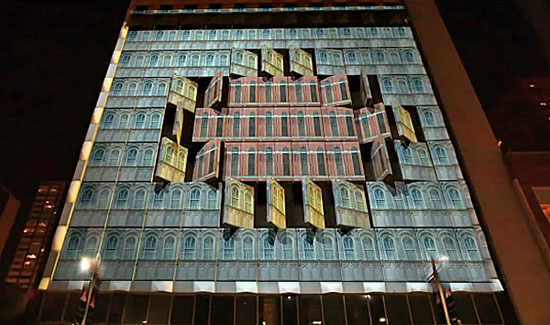
Like the tranformation of this Dallas building, a spectular "3D digital mapping" show is planned for City Hall.
From the first, it was part of the civic vision—a big, free, central place where Los Angeles would, for once, come together in public on New Year’s Eve.
Even while it was on the drawing boards, Grand Park was being touted as a rival to the big, cold-city countdowns that have always seemed to have the market cornered on December 31st at midnight. At meetings, civic leader Eli Broad talked excitedly about the notion, envisioning televised images of a 12-acre party between The Music Center Plaza and L.A. City Hall.
Now, at last, Grand Park will step up with its first New Year’s Eve celebration, an event that, at least for now, may not draw the hundreds of thousands annually estimated at Times Square, but that is expected to set its own kinds of records with a dazzling technological display that will be the largest of its kind ever attempted on the West Coast.
Of course, there’ll be live music, dancing, food trucks and a cash bar. But the highlight is expected to be a colossal presentation of so-called “3D digital mapping”—a high-tech urban art form that will make L.A.’s iconic City Hall do some things that it may have to blame on the champagne in the morning.
“I don’t think anyone in L.A. has done anything on this scale,” says Jonathan Keith, creative director at Idea Giants, the local consortium of 3D special effects artists who created the extravaganza.
The technology, which employs projectors and sophisticated 3D models to make art out of ordinary landscapes, has been used to turn skyscrapers into everything from ancient ruins to giant dancing monkeys. Windows can seem to extrude, walls can seem to fall away, and—in one stunt hinted at by the creators of the New Year’s Eve show—whole landmarks can seem to disappear and be replaced by Grand Park’s renovated jewel, the Arthur J. Will Memorial Fountain. (Click here for a sample of what digital mappers can do to an unsuspecting building.)
Keith says his team will use a 20-foot stack of five 40,000-lumen projectors weighing about 500 pounds each—state-of-the art equipment. “I believe we have every 40K projector in California for this event,” Keith says. “We needed some major fire power with a structure the size of City Hall.”
The party is the most ambitious undertaking yet for park programmers, who have built audiences for the new downtown destination through a number of high profile events. The biggest was on the Fourth of July, when some 10,000 revelers flocked to Grand Park’s lawns to watch fireworks, but thousands also have gathered for events ranging from a live screening of the 2012 Presidential Elections, Mayor Eric Garcetti’s swearing-in celebration, an assortment of outdoor concerts and CicLAvia.
To that end, Julia Diamond, the park’s director of programming, says organizers have tried to err on the side of caution in planning the New Year’s Eve celebration. Although they’re planning for a repeat of the Independence Day attendance, they also avoided bringing too much celebrity wattage to the entertainment lineup, lest a too-massive turnout spoil the park’s vibe.
“I think especially in this early period, the event isn’t about a person or a band, especially on New Year’s Eve,” says Diamond. “Maybe down the road we’ll go with a big national name, but right now, this space isn’t a 100,000-person venue or even a 30,000-person venue.
“We don’t want to re-create the kind of experience you have at Times Square, where you’re smashed into a packed concrete space where you can’t sit down and can’t move and can’t eat. And the bigger names you have, the more you get of those logistical issues. We want people to come in, find a bench, spread out and enjoy themselves with their families.”
A key question, of course, is: What will the countdown look like? Organizers have been close-lipped about the details, but they will confirm that they don’t want their clock to strike midnight the way Times Square’s does either, although there will be a live feed of the ball dropping for early birds at 9 p.m.
“We can represent the passing of time in ways that are much more creative and dynamic and sleek now,” Diamond says. “The ball dropping is great and iconic, but it’s really analog.”
Beyond that, Diamond says, there will mostly be brightness and action. Images of revelers and their hopes for the New Year will be projected on the Hall of Records, as will names of the various communities of Los Angeles County.
“The first thing people will notice is a sort of neon takeover of the park,” she says. “You’ll be surrounded by lights and color and New Year’s Eve.”
The party will also showcase art installations symbolic of the city by Michael Murphy, Geoff McFetridge and Charles Baker, and dancing by the hip-hop Versa-Style Dance Company.
Dublab, an L.A. nonprofit web radio collective, will provide music, and Fool’s Gold, a Los Angeles Afropop collective, will headline and ring in 2014 with their rendition of “Auld Lang Syne.”
In short, she says, midnight on December 31 promises to be a lot like L.A.—light-hearted, cutting-edge, and—at least lately—a little more interested in community.
“This hasn’t been a place where New Year’s Eve is celebrated collectively, but I think people are more interested in coming together,” says Diamond. “What we’re building is a new tradition for L.A.”
Posted 12/12/13
The day I met Mandela
December 10, 2013
Los Angeles City Hall has played host over the years to heads of state, visiting dignitaries and many of the world’s great and near-great.
But one visit on June, 29, 1990 by a smiling septuagenarian fresh out of a South African prison stands in a class of its own.
Crowds waited hours in the sun to see Nelson Mandela, the living embodiment of the struggle against apartheid, as he came through our city on what all of us sensed was a march of destiny for his country and the world.
Mandela was introduced by Gregory Peck, embraced by Sidney Poitier and lauded as a hero by Mayor Tom Bradley. Harry Belafonte was there that day with his video camera. I’d brought mine from home, too, and we ended up videotaping each other.
The atmosphere was electric as thousands waited for a glimpse of Mandela. Some climbed trees, craning to get a better look.
Just five years earlier, while Mandela was still imprisoned on Robben Island, I had as a Los Angeles city councilman helped lead divestiture efforts that prompted withdrawal of city deposits from banks doing business in South Africa and halted some pension fund investments in companies with connections there.
Now, here was Mandela himself, paying tribute to those actions and many others that were bringing inexorable pressure to the fight to end the inhumanity of apartheid.
“Thank you for supporting us when we needed you most,” Mandela told us that day. “Thank you for remembering us even though we were incarcerated in prison dungeons thousands of miles away from here. Thank you for caring. We are on freedom road, and nothing is going to stop us from reaching our destination.”
After the speeches, at a reception hosted by the mayor, I had a chance to shake Mandela’s hand and exchange a few words with him. There was so much I wanted to say about my admiration for him, but with the crush of people all around us, there was only time to exchange a few casual pleasantries. Still, it was an opportunity I treasure to this day.
Not just because it was a chance to meet a personal hero, someone I’d admired from afar since my own early days as a human rights activist. But also because of what he showed the world following his release after 27 long years in prison. It was inspiring and remarkable to me that when he came out, retribution was not on his agenda—reconciliation was. When he went on to lead South Africa as its president, he was inclusive. Healing his beloved country would take working together, and no one showed the power of a collaborative spirit more than Mandela.
He set an enduring example of cooperation and selflessness that’s not often seen in public life these days.
As Mandela was memorialized after his death last week at the age of 95 by leaders including President Barack Obama in Johannesburg, I found myself thinking about the power of individuals to change the world—the importance of taking a public stand against injustice, and of lending our vocal and moral support to those, like Mandela, who put their necks on the line for a cause greater than themselves.
Every generation has its heroes—those all-too-rare individuals who stand up and make a difference. In our times, they’ve included the late Andrei Sakharov, the “voice of conscience” against human rights abuses in the Soviet Union and the inspiring Aung San Suu Kyi in Burma. But no one, I would argue, had the impact and experience of Mandela, who paid such a profound price in terms of the years of solitary confinement, yet emerged from behind bars to see the comparatively swift demise of the apartheid system he fought so effectively against.
He stands alone. And those of us fortunate enough to have even once crossed his path will always stand in awe.
Posted 12/10/13
This parking lot’s no paradise
December 6, 2013
On a chilly weekday morning, after squeezing his truck into the last available spot in the main lot at the Universal City/Studio City subway station, Mario Beltran summed up the parking situation in two words: “It’s terrible.”
“If you’re not here by 8 o’clock, you’re out of luck,” said Beltran, 36, as he hurried to catch a train to downtown L.A.
Beltran was lucky that day. According to some of his fellow commuters, lots are often filled up by 7:30 a.m. or even earlier at both of the Valley’s Red Line stations, in Universal City and in North Hollywood.
Some, like 25-year-old Joanna Sintek, who commutes from Burbank to the Natural History Museum in Exposition Park, have had to learn that the hard way.
“I would show up and get grumpy and have nowhere to park,” Sintek said. “I’d just drive instead.”
Since then, Sintek has discovered an L.A. County-owned overflow lot on Ventura Boulevard, but she said it’s a long haul from that lot to the station entrance, and it comes with an uncomfortable passage through a poorly-lit pedestrian tunnel beneath the 101 Freeway.
Parking can be tough in many parts of the city, but the two San Fernando Valley subway stations get extra pressure because they serve as the main transit gateways to Hollywood and downtown L.A.
Help may be on the way. On December 5, Metro’s Board of Directors unanimously passed a motion by L.A. City Councilman Paul Krekorian, County Supervisor Zev Yaroslavsky and Mayor Eric Garcetti, instructing the agency to investigate possible fixes, such as additional lots, parking garages or a joint development project to increase parking. The motion also directs staff to report back on bicycle and pedestrian improvements that could be made to the stations and surrounding areas.
There are currently 951 spaces at North Hollywood—300 of which are reserved at a cost of $39 per month. At Universal, there are 661 spaces, 140 of which are reserved. The County-owned satellite lot has 160 more spaces.
Robin Blair, Metro’s director of planning, said the agency already is in the process of installing a lot in North Hollywood that will accommodate 187 more vehicles, but he admitted the effort wouldn’t satisfy the rapidly-growing demand.
“There isn’t enough parking, that’s the bottom line,” Blair said.
Metro owns several parcels adjacent to the stations, but Blair is skeptical about building parking-only structures because of the high value of the land, which is located in popular areas like the NoHo Arts District and Universal City. “The sites are valuable as destinations and you are going to have pressure to do some sort of joint development,” he said. “Once you get in the discussion of parking garages, that’s not an option.”
The North Hollywood station is the northern terminus of the Red Line, and Blair said the “transit-shed” of the station—the geographical area from which it draws passengers—is enormous. It is used by about 33,500 people on an average weekday, bringing in people from North Hollywood, Burbank and much of the west San Fernando Valley via the Orange Line. Commuters from as far north as Palmdale drive to the station.
Because of that ridership and the potential for further growth, Blair hopes the station areas themselves can become destinations where people can eat, shop and hang out. That’s in sync with the motion’s intention to create “transit/mobility hubs” that would bring more riders into Metro’s system—and not necessarily just those who get there by car.
For bike advocates, new infrastructure is crucial because the stations border the Orange Line Bike Path, the Chandler Bikeway and a future section of the L.A. River Bike Path that’s in the pipeline. Those paths approach the stations but the parking lots were not designed for bicycle access, said Eric Bruins, director of policy and planning for the L.A. County Bicycle Coalition. He added that the stations bookend a stretch of Lankershim Boulevard where the group is pushing for bike lanes. “If you connect these two hubs with lanes, that neighborhood will really take off,” he said.
The move to create better access to the subway stations is one of three recent proposals that aim to improve the San Fernando Valley’s public transportation experience.
After residents around Pierce College complained that Orange Line patrons were urinating on their walkways and alleys because of a lack of bathrooms, Yaroslavsky, Krekorian and Supervisor Michael D. Antonovich moved to have the agency install bathrooms or come up with another solution. Their motion, adopted by Metro’s Board of Directors last week, also calls for the agency to look into adding bathrooms throughout its rail and bus rapid transit system. Blair said that could be a tall order, however; because of security and maintenance needs, having bathrooms at all stations could cost an estimated $70 million or more a year.
Finally, a motion by Yaroslavsky and Krekorian, adopted by the full board, seeks to curb freeloaders on the Orange Line, where fare evasion enforcement is falling short of the agency’s goal, with officers conducting checks only one-third as often as they should. Potential solutions could include increased enforcement, adding gates to stations, installing additional TAP card readers or improving signage.
For Carlos Mora, a commuter who has lived in transit-friendly cities like London and New York, such fixes are overdue steps toward improving what he calls “the crappiest infrastructure for public transportation ever.”
“It’s getting better,” Mora added, as he headed towards the parking space that he’d waited two months to reserve. “But if it was more these hubs where people could work and live and shop and entertain? That would be awesome.”
Posted 12/6/13
Making spirits bright
December 6, 2013
The holiday season demands a soundtrack, and for many musicians, this is one of the busiest times of the year.
Just ask Jane Sarture what her ensemble is up to these days.
“We played this morning in a real estate office,” Sarture said. “We’re going to go out to hospitals, senior centers, the Ronald McDonald House charity Christmas party. We’ll be playing at Olive View hospital. We’re going to be at the Kaiser farmer’s market… I don’t think I ever stopped to count yet but I think we have 25 performances across 24 days.”
Sarture is a music director, but she’s not leading a local orchestra, singing group or jazz combo. Her musicians are developmentally disabled adults who play in the ARC Handbell Choir.
Their rendition of “Jingle Bells” may not be the slickest version you’ll hear this season, but it’s undoubtedly the most heartwarming.
“It is inspiring,” said Sarture, 52, a former associate producer of television game shows who switched careers to work at ARC 22 years ago and now accompanies the group on keyboard during their performances.
“The first day I walked in, I was like, “This is so cool.’ It’s like that old cliché: it’s not a job, it’s a calling,” she said of her work at the non-profit ARC (Activities Recreation and Care). The North Hollywood organization offers adults with cognitive disabilities a chance to take part in a wide range of life-enriching activities, from camping and field trips to volunteering at senior centers and even running marathons. The handbell choir is one of the most visible manifestations of the organization’s mission; they’ve performed 11 times since 1999 in the county’s Holiday Celebration, which is broadcast live on KCET. (This video captures one of their previous performances.)
This year, they’re returning to the stage of the Dorothy Chandler Pavilion for the 12th time to perform in the annual Christmas Eve extravaganza, produced by the county Arts Commission and featuring an array of performers in many genres. If past experience is any indication, look for the audience to respond to the handbell choir with a rousing ovation—and perhaps a discreet tear or two.
“People are amazed,” said Jennifer Davis, an ARC employee who conducts the ensemble’s performances and also serves as the organization’s volunteer marathon coach. She ran the New York Marathon this year with ARC client Jimmy Jenson, who has Down syndrome and received national acclaim on the “Today” show for his accomplishment.
“A lot of times people see the young, cute babies and they don’t know what happens [to the developmental disabled] when they grow up,” Davis said. “You’ll see people with tears streaming down their faces and they’ll say ‘I have a six-year-old and to think that my child can grow up and live such a phenomenal life.’ ”
Davis said an overarching message behind the group’s success is a determination to look past what people can’t do and focus instead on what each individual is capable of.
“When we look at what we can do, and what we can contribute, that’s when community and the real music in life happens,” she said.
ARC’s handbell choir has been jingling all the way since 1985 and now performs year-round.
They don’t charge for their performances, but happily accept donations, which Sarture said can range from “a great lunch and a couple of candy canes” to a check for $50 or even $2,000.
It all comes in handy when you’re trying run a handbell choir.
“It’s an expensive operation,” Sarture said. “If you drop a bell, it’s $200.”
There’s plenty of music in the air, but one thing you won’t hear from this group is any complaining about how busy things get when the holidays roll around.
“It’s amazing,” said one performer, 34-year-old Hillary Shaw, after an evening performance at a holiday open house in Supervisor Zev Yaroslavsky’s Van Nuys district office this week.
And as for Sarture? “It’s a blast,” she said. “It’s my favorite time of the year.”
Posted 12/6/13
Some major night closures on tap
December 2, 2013
The entire southbound 405 Freeway will be closing from Sunset Boulevard to Santa Monica Boulevard for overnight work on Monday and Tuesday, Dec. 2 and 3. That work will be followed on Wednesday, Dec. 4, with the overnight closure of all lanes of the northbound 405 from Santa Monica Boulevard to Moraga Drive.
Metro is providing detour details and other information about the closures in separate construction notices, one for each night of work. Click here for Monday, here for Tuesday and here for Wednesday. Travelers, take note: ramp closures will start as early as 7 p.m., with freeway lanes closing starting at 10 p.m. and reopening by 5 a.m. the following morning.
Construction workers will be restriping lanes each night as part of the effort to widen the freeway.
Work on the long-running project, to construct a 10-mile northbound carpool lane along with other improvements, is 85% complete, but some construction is expected to continue into next year.
Posted 12/2/13
Embracing a second chance
November 25, 2013
Gratitude is rare in criminal courtrooms, but for the women gathered on a recent Friday before Los Angeles Superior Court Judge Michael Tynan, thanksgiving was everywhere.
One was clean after an addiction that had crippled her since age 7. Another was in sober living after 30 years of shuttling between Skid Row and prison. Yet another was a middle-aged ex-con when she hit her deepest bottom, and she wept as she described the redemption she shared with the five women beside her.
“I was so tired,” 55-year-old Donna Majors said last week, as prosecutors and parole officers brushed away their own tears at the small graduation ceremony in Tynan’s downtown courtroom. “And I was given the chance to finally face my demons, to know who I am and finally be at peace.”
If the emotional scene seems a far cry from standard L.A. criminal justice, it may be because the program that spawned it is a departure as well. Since 2007, the Second Chance Women’s Re-Entry Court has been among the most successful diversion programs in Los Angeles County, offering an intensive yet cost-effective alternative to prison for hundreds of high-risk female felons.
The program targets parolees and probationers charged with new offenses, channeling them into a 6-month residential substance abuse treatment program in lieu of another term behind bars. That rehab, at the nonprofit Prototypes residential center in Pomona, is followed by up to 18 months of tightly supervised outpatient treatment, plus services ranging from parenting classes to educational and vocational training.
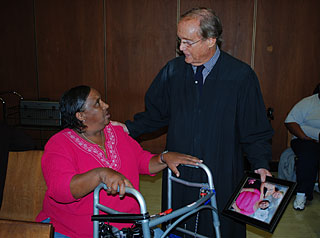
Judge Tynan greets program alum Georgina Moore, who presented him with a picture of her and her daughter.
Each woman checks in regularly before Tynan, who consults with therapists and court officers to determine when a participant can move to the next level of treatment. Those who relapse or reoffend return—often remorsefully—to county jail or prison, but most move on to sober housing, family reconciliation and even jobs and college.
At last count, 295 women had been formally admitted and 61 had gone back to jail or prison, according to a recent review conducted by the Public Defender’s Office. About 90% of the recidivists, the review found, were women who had not yet completed their treatment.
Of the 125 who have graduated so far, the review found, only eight—about 6%—have since gone back to jail or prison. By comparison, according to state figures, the recidivism rate in 2011 was 55.1% for female inmates.
“You’ve come a long way,” the judge told a glowing ex-con at the most recent graduation ceremony, glancing at a file that included her latest report card from Mt. San Antonio Community College. “You got an A at Mt. SAC! Congratulations! Gimme a hug! I remember when you came through that door looking like something the cat wouldn’t have dragged in on a bet.”
Well into his 70s, Tynan notes that he could be retired. But the judge—who also presides over the county “drug courts” and alternative sentencing programs for the mentally ill, military veterans and others—says that his is a labor of love.
This has been particularly true lately, he adds, as funding concerns have been looming over the program because of a new state law aimed at putting the brakes on California’s burgeoning state prison population. Under the AB 109 law, known as “realignment,” the county, rather than the state, has been given responsibility for supervising and incarcerating offenders whose most recent convictions are for non-serious, non-violent, non-sexual offenses.
But because the Women’s Re-Entry Court is largely underwritten by a state grant for parolees, women who once were prime candidates for the program—street people, hustlers and others whose long criminal histories stem from drug habits—are now ineligible because the state no longer supervises them.
And the county, which now oversees these offenders, doesn’t directly fund its Re-Entry Court participants. Under AB 109, these offenders are being channeled into other, less intensive programs underwritten by realignment money. If they re-offend now, they can only be placed in Re-Entry Court if an alternative funding source pays for their treatment—a grant for AIDS patients, for example, or for pregnant women.
Meanwhile, officials say that parolees who remain under state supervision now often require special consideration to get into the program, because they are more institutionalized, with more serious convictions.
Shari Crome, an assistant unit supervisor with the California Department of Corrections and Rehabilitation, says she’s frustrated “because I’ve been here almost since the beginning of the program, and I’ve seen the successes. There’s nothing else like it in the state, and it works.”
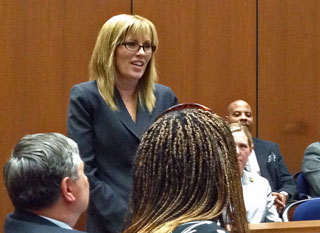
Deputy Public Defender Nancy Chand, a key member of the re-entry court team, congratulates the grads.
Deputy Public Defender Nancy Chand, who has represented most of the Re-Entry Court women, calls the AB 109 funding snag a rare sour note in a program that has transformed some of the most desperate lives in L.A.
“These women are really scarred,” Chand says. “Most come in with horrific trauma, and were victimized as children, enduring severe physical, sexual and emotional abuse and abandonment. Some can’t read and write. Some can’t work. Eighty-one percent have one or more mental health diagnosis and 50 percent have two or more. As one of my clients put it, they’re literally scraped off the streets.”
Currently, Tynan says, about 60 women at any given time are enrolled in the program, a little more than half of them paid for through the $500,000 annual state correction’s grant and the rest covered by a shifting and uncertain patchwork of federal, state and county grants to Prototypes.
The cost is about $18,000 a year for each woman, versus an incarceration cost of close to $50,000 a year in prison or more than $36,000 a year in county jail, not counting medical and mental health care. Officials at the Public Defenders Office estimate the program has saved tens of millions of dollars; many of its participants had been facing jail or prison sentences of 10 years or more.
Barbara Dunlap, for instance, was a 58-year-old homeless addict with 15 prison terms under her belt by the time she entered the program.
“I discovered alcohol before I started school, and I started school at the age of six,” Dunlap says. Her babysitter sold her to men when she was a child and by 21, she says, she was a prostitute with a criminal record. By the time her public defender sent her to Tynan’s courtroom, she was a 58, suffering from AIDS and hepatitis and was wheelchair-bound as the result of surgery stemming from a poisoned heroin injection.
Now 61, she is sober, living in permanent supportive housing, enrolled in college classes and a mentor at Prototypes. And at the ceremony in Tynan’s courtroom, she addressed the most recent graduates from her electric wheelchair, rolling back and forth across the courtroom, testifying like a preacher as a dozen state corrections officials watched from the jury box.
“When they found me, I was on the streets, and I don’t even know how they told me from the sidewalk—I was cold, my life was filled with stench and I was gray, without any life in me,” she proclaimed, her voice trembling.
“But they treated the whole woman—my health issues, my substance abuse issues, my anger issues. I didn’t know that anyone understood people like me.”
Taking the podium in Dunlap’s wake, the graduates told their own harrowing stories, weeping with gratitude as they thanked their therapists, probation and parole officers, prosecutors and defenders, families and, of course, the judge.
Brigitte Benjamin, 52, told the group that she had spent 30 years on Skid Row, and had expected to die there. Now, she is in a sober living facility and working toward her GED after 30 years on Skid Row.
Helen Navarro credited Tynan and Prototypes with forcing her to confront the roots of her addiction for the first time in the 20 years she had spent cycling in and out of prison on robbery and burglary charges. “I didn’t want to go deep-deep-deep,” said Navarro, a 51-year-old recovering crack addict—now sober and working as a receptionist at a country club in the San Gabriel Valley. “The counselors made me look at myself.”
Sandy Raymond, a 48-year-old mother of two who had lost more than half her life to crack addiction, did a little dance as Tynan handed her a certificate of completion. “I didn’t know nothing but going in and out of jail and stealing stuff,” she said. “But now I’m a secretary. I love my life.”
Over cupcakes and high fives from their families, the women also quietly gave thanks for the inner strength they were able to muster.
Brandishing her graduation certificate after decades of crime and addiction, Mary Willis said that for the first time in 25 years, she now has a relationship with her children. “I will always keep in the back of my mind what Judge Tynan told me,” she said proudly. “Give yourself a chance.”
Posted 11/25/13
A healthy helping of thankfulness
November 22, 2013
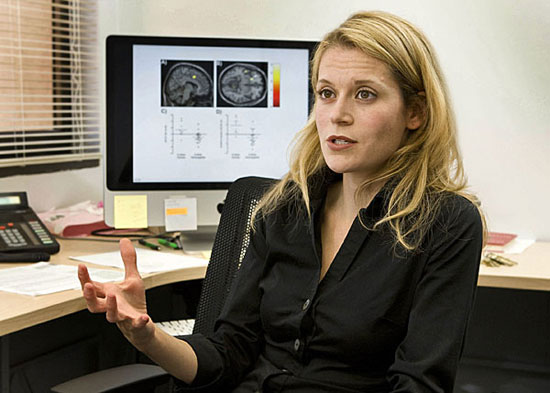
Naomi Eisenberger of UCLA is among the researchers working to expand our understanding of gratitude.
Giving thanks—it’s not just for the fourth Thursday in November anymore.
Researchers in the burgeoning field of gratitude science are finding a host of psychological and physical benefits associated with feeling and expressing thankfulness.
Gratitude has been linked to reduced depression, increased optimism, fewer physical ailments and more of that feel-good neurotransmitter dopamine in the brain.
It’s not all new—cultivating an “attitude of gratitude” has long been a part of 12-step addiction recovery programs—but there’s growing excitement about the expanding frontiers of such research and about finding new ways to scientifically document the effects of being thankful.
At UCLA, for example, Naomi Eisenberger, an associate professor of psychology, is in the midst of a project in which the participants—women ranging in age from 30 to about 60—go through a six-week “gratitude course” involving writing about things for which they’re thankful. Blood samples taken before and after the course will be compared to see whether inflammation levels, linked to a number of chronic diseases, have been affected by the gratitude exercise.
“We want to see in this study whether this gratitude intervention can actually reduce some of the inflammatory activity that we’re seeing in these individuals,” Eisenberger said.
Eisenberg’s research is part of a broader effort by the Greater Good Science Center at UC-Berkeley to “expand the scientific understanding of gratitude.” The Center, with funding from the John Templeton Foundation, last year awarded $3 million in grants to researchers across the country for a wide range of studies, including exploring how gratitude affects romantic relationships, healing after a heart attack, health and resilience in aging, and what people choose to purchase—experiences vs. material objects—in a “consumerist society.”
“This research is exponentially growing and we hope can have a continued impact in the world,” said Emiliana Simon-Thomas, the center’s science director. “Gratitude isn’t a new idea, right? There’s certainly a long tradition of different philosophical frameworks or religious traditions that embrace and promote gratitude practice. But for many it’s important to also have this empirical base [to demonstrate that] this is something that serves ourselves and our communities in a profound and measurable way.”
Even as the science expands and new discoveries proliferate, one fundamental remains the same: practicing gratitude is free and accessible to just about everybody.
“It’s shocking how simple it is,” Simon-Thomas said. (Some tips on getting started from the Greater Good website are here and here.)
But here’s something to keep in mind if you’re counting your blessings around the Thanksgiving table this year: it seems that not all gratitude is created equal.
“What the research is starting to uncover,” Simon-Thomas said, “is a pattern showing that gratitude towards people, particularly gratitude expressed—not just felt, but expressed—is actually the most powerful form of gratitude, one that has the most bang for your buck in terms of its impact on your day-to-day psychological experience.”
Marvin Southard, director of the Los Angeles County Department of Mental Health, sees a “use-it-or-lose-it” pattern emerging in some of some of the recent research into the workings of the brain.
“It’s like a muscle. If you use certain muscles, they get stronger. The muscles that you don’t use get weaker,” he said. “It’s the same thing with the way the neurotransmitters work in our brain…There actually has been some clinical work done to show that focusing on positive things, cultivating a sense of gratitude for the things that have happened in one’s life, even for people who are suffering from a chronic illness, produces better health outcomes for those individuals.”
In some ways, the new gratitude research is less about re-inventing the wheel than providing giving scientific credence to something that’s long been a part of the therapeutic experience.
“The sense that things like meditation and gratitude are good for you is common sense in a certain sort of way,” Southard said. “And I guess what ended up surprising me is that there seems to be so much scientific neurological research that supports those things that in the past we would have just taken for positive common sense.”
Robert Emmons, a UC-Davis psychology professor and author widely seen as the foremost pioneer of gratitude research, said the subject has exploded both in the popular imagination and in research because it works.
“The topic has become popular because people realize what science is now proving—that there is remarkable power in gratitude to heal, to energize, and to change lives,” Emmons said in an email. “There is a new generation of gratitude researchers out there who are examining the health effects of gratitude. Some of the findings are really amazing. They are using state-of-the-art measures of biomarkers of health and aging.”
And how do the mental health and neuroscience professionals themselves get their gratitude on?
In Simon-Thomas’ case, a nightly game of “Rose, Bud, Thorn” around the family dinner table is just the ticket.
“Rose is something that you’re really grateful for, that you want to think about and appreciate,” she explained. “The bud is something that you’re looking forward to, that you’re excited about happening in the future. The thorn is something that’s difficult that happened…It’s nice to do every day. It sort of keeps us all in touch and gives us more insight into what’s going on with each other and with ourselves.”
Emmons watches how he communicates: “I like to use the language of gifts. Think of the benefits you received today as gifts. Relish and savor the gifts you have been given. That’s what I do and what I suggest people try.”
As for Southard, he’s found something that serves him well, even on those marathon board meeting Tuesdays at the Hall of Administration.
“I meditate twice a day and at the end of each session I try to be conscious of the blessings in my life—even on Tuesday.”
Posted 11/22/13
Remembering JFK
November 22, 2013
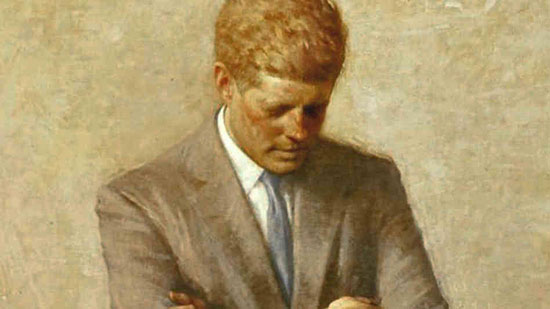
John F. Kennedy's official presidential portrait by artist Aaron Shikler was posthumously unveiled in 1970.
It was the fall of 1960, just two months before the presidential election, and John Kennedy was making a swing through Los Angeles for a rally at the Shrine Auditorium. I was 11, and I was determined to be there.
Kennedy already was my hero. When he challenged us with his youthful energy to give more of ourselves in the service of others, he sparked a political flame in me. So I begged my dad to take me to the Shrine. Before we jumped into our Plymouth for the drive downtown from our Fairfax home, I grabbed a stick in the backyard and taped a Kennedy bumper sticker to it.
When we arrived at the Shrine, the place was mobbed. We couldn’t get inside but, because I was small, we snaked and jostled our way through the thick forest of excited grown-ups to the very front of a walkway where Kennedy would pass to enter the auditorium. As my striding hero approached, I shouted and waved that stick so wildly that he had to step back to keep from getting whacked.
Inside the auditorium, the candidate would speak on the weighty matters of the day—the tightening tensions between democracy and communism, survival in a difficult and dangerous world, racial and religious bigotry. As I sit here now, I suspect most of those policy points would have gone over my head. But the promise of a New Frontier that Kennedy carried into L.A. and across the nation certainly didn’t miss the mark with my heart.
In recent days, we’ve seen stories of every sort and slant on Kennedy and his administration to commemorate the 50th anniversary of his assassination in Dallas on November 22, 1963. Scholarly debates over the impact of his presidency will persist for decades to come. So too, I imagine, will the lingering conspiracy theories that swirl around the rifle shots fired by Lee Harvey Oswald.
But in my circle of friends, we’ve found ourselves talking less about the details and what-ifs of JFK’s presidency and more about his personal impact on the course of our lives during such formative ages. Truth is, many of us have never gotten over Kennedy’s death. It was so sudden, so personal. In that sense, it reminded me of the grief of my mom’s passing just four years earlier.
During Kennedy’s tenure, we were still too young to be skeptical or, worse, cynical from the experience of some earlier political disappointment. When John Kennedy said anything was possible, we believed. When he told us we could make a difference, we acted—even if it was in our own, youthful ways.
I can still remember running for Boy’s League vice president in 9th grade at Bancroft Jr. High School in Hollywood after Kennedy’s election—my first political race. During a campaign “speech” to the students, I informed them that a special guest was there to offer support for my candidacy. I turned around and pulled on a Kennedy mask that I’d been hiding behind my back. I then swung around again and, in what I’d like to think was a pretty spot-on Kennedy impersonation, urged the now-cheering students to cast a ballot for Zev. I won, with 90 percent of the vote.
Today, I look back at my silly play-acting and know, on a deeper level, that I was identifying for the first time with a real-life political figure, an identification that has inspired me throughout my nearly 40 years in elective office. The political activism to which I’ve dedicated my life began with Kennedy.
During the past few days, amid all the news coverage, I’ve been asked the difficult question of how I think the Kennedy assassination is relevant to today’s younger generation. Why should they care?
Many historians have asserted that the political and cultural upheaval of the 1960s—which informs much of who we are today—began on that sad day in Dallas. The president’s killing set the stage for the assassinations of Martin Luther King, Jr., Bobby Kennedy and too many others, seemingly raising the nation’s tolerance for political violence.
But the reality is that for those of us of a certain age, our most visceral connection to the assassination is with the seared memories of where we were and how we felt when we heard the news. (I was in Spanish class, where my teacher dissolved into tears.) The gut-wrenching depth of that individual grief, multiplied by millions across a nation, can never truly be expressed to anyone who wasn’t there.
Maybe the most we can do to convey that trauma to the Millennial Generation is to note the impact the 9/11 attacks had on their lives. Ask any of them, and they can vividly tell you where they were when the towers of the World Trade Center came crashing down.
But, on a more positive note, I might also offer them a few words from the speech that candidate Kennedy delivered inside the Shrine Auditorium, as my dad and I worked our way back to the car—a reminder of the timeless relevance of his vision and of our responsibilities.
“If we measure up not only in the public sense,” Kennedy said, “but in the private sense to the opportunities that we have, if we recognize that…liberty calls for certain qualities of self-restraint and character which go with self-government, I am confident that the future can belong to those who believe in freedom.”
Posted 11/22/2013




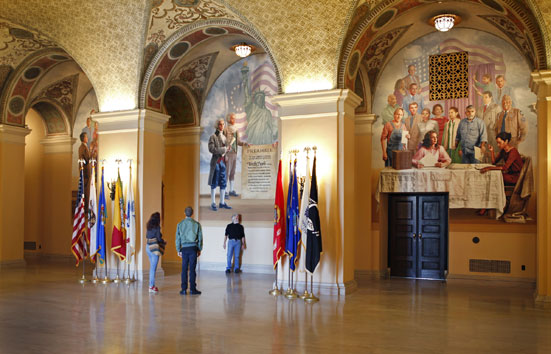
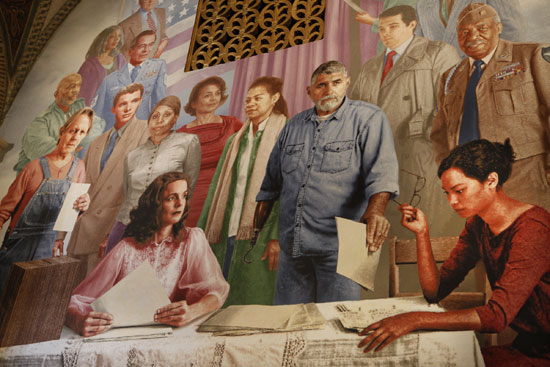
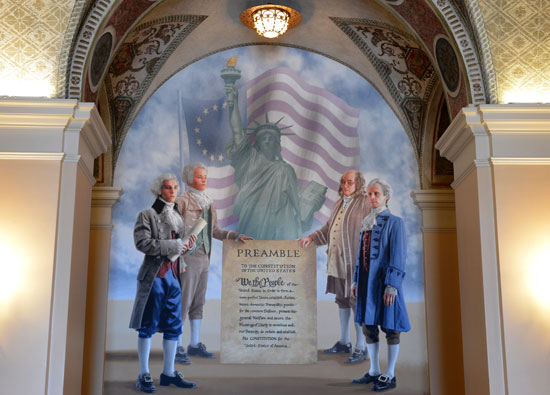
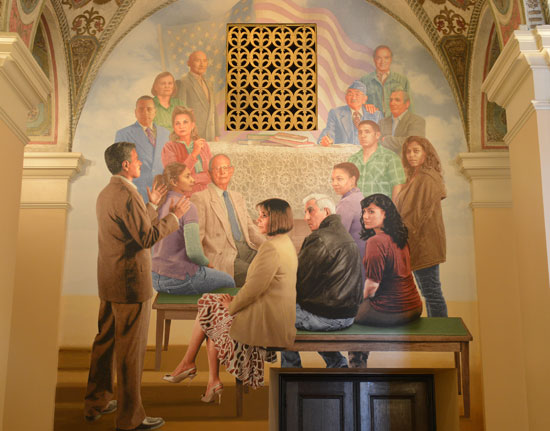
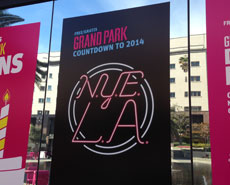
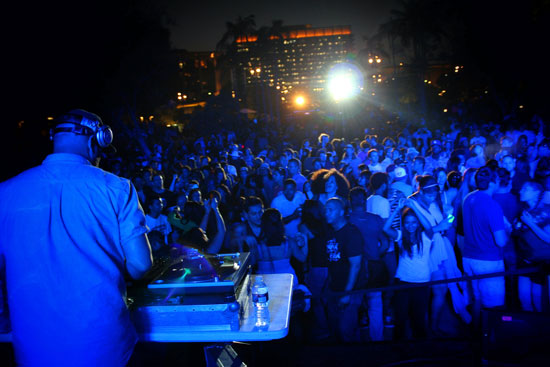
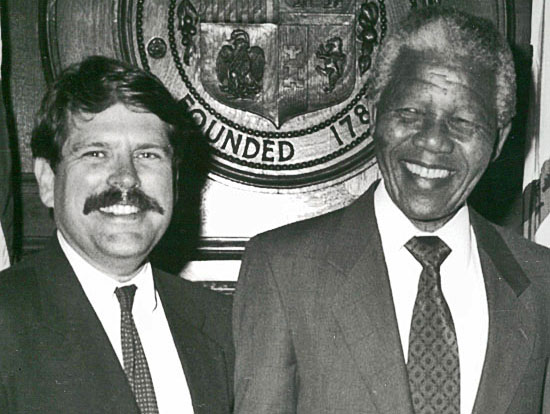
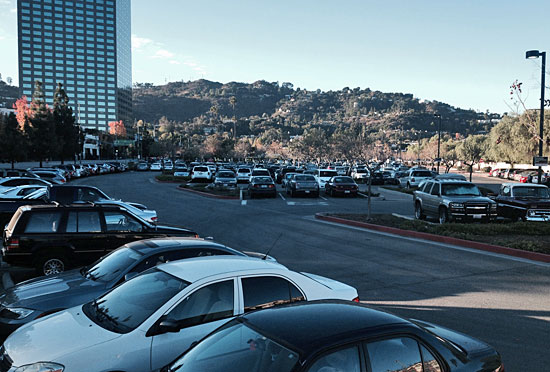
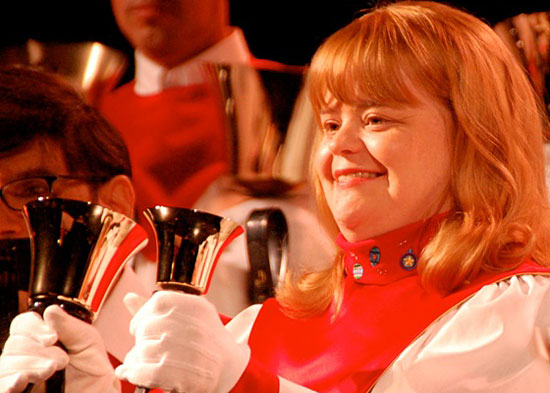

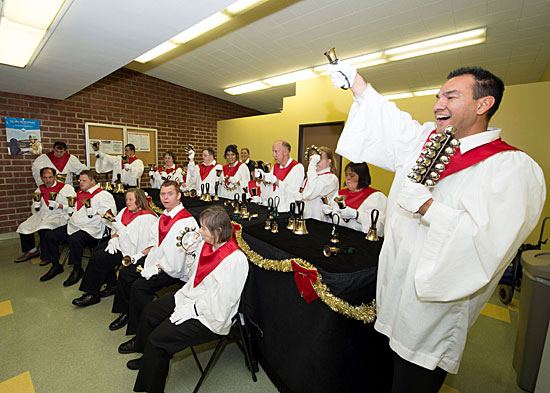
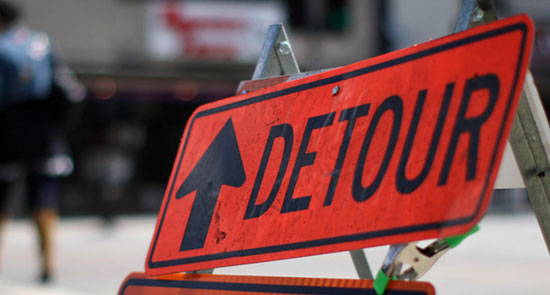
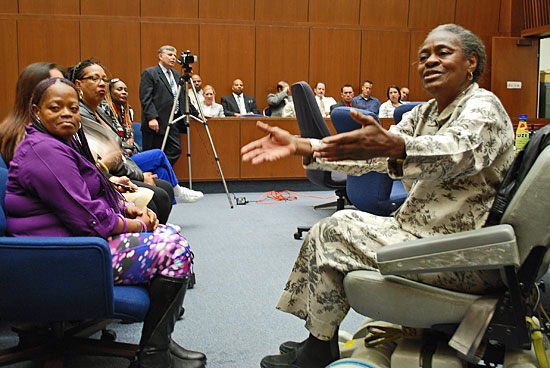
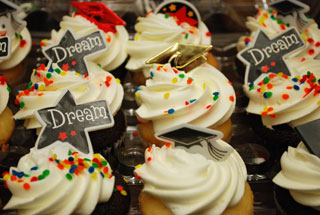
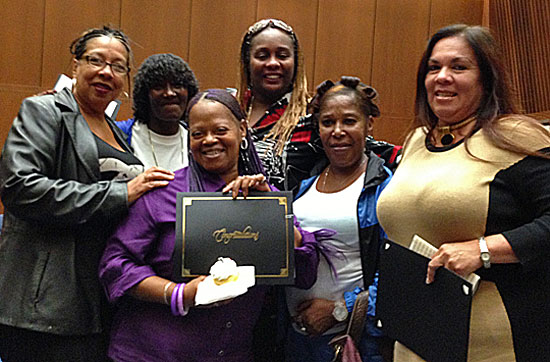






 Check for the latest closure information
Check for the latest closure information








